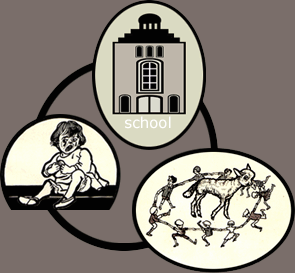
|
For hundreds of years in Eastern Europe, Jewish children had attended the kheder, the traditional Jewish school. Starting at age 4 or 5, boys (girls rarely attended) would spend long hours - 10-12 hours perhaps - studying first the alphabet, then prayers, then the Bible, and finally the Talmud. The teacher was the melamed and was addressed as "rebbe." This was not a prestigious position and paid very little. The language of instruction was in Yiddish. In America, the vast majority of Jewish children attended the public schools. Starting in the 1910s, a secular "folkschul" [folk school] movement began which sprouted Yiddish afternoon schools with varying ideological thrusts. The major folkshul networks were the progressive and socialist Sholem Aleichem Folk Institute/Workman Circle Shuln and the Communist Arbeter Ordn Shuln. During the summers, many children would get out of the hot cities and participate in the Yiddish summer camp movement. These folkshuln inspired a wonderful Yiddish children's literature in the United States in the form of Yiddish children's journals, Yiddish children's books, and instructional primers for learning the Yiddish Language. |